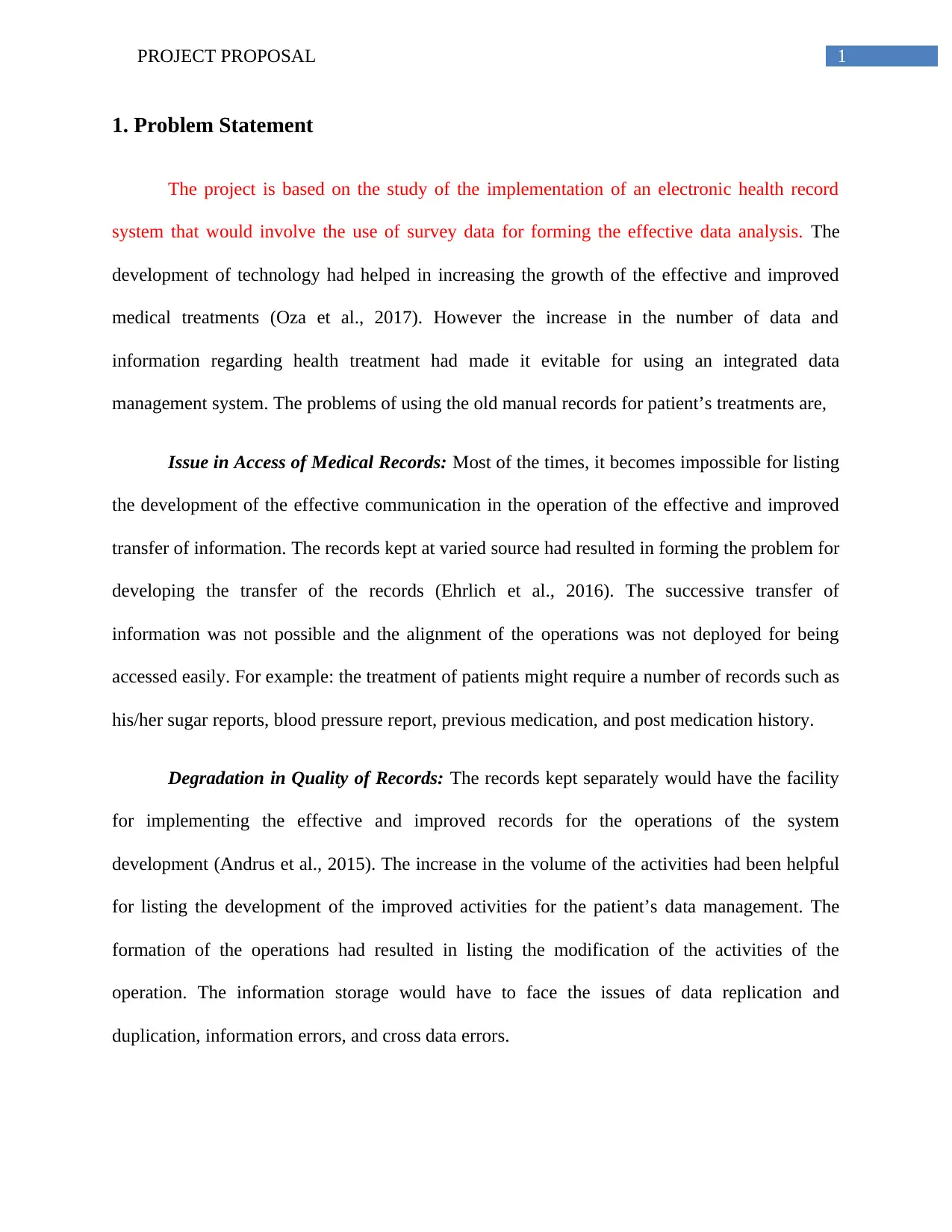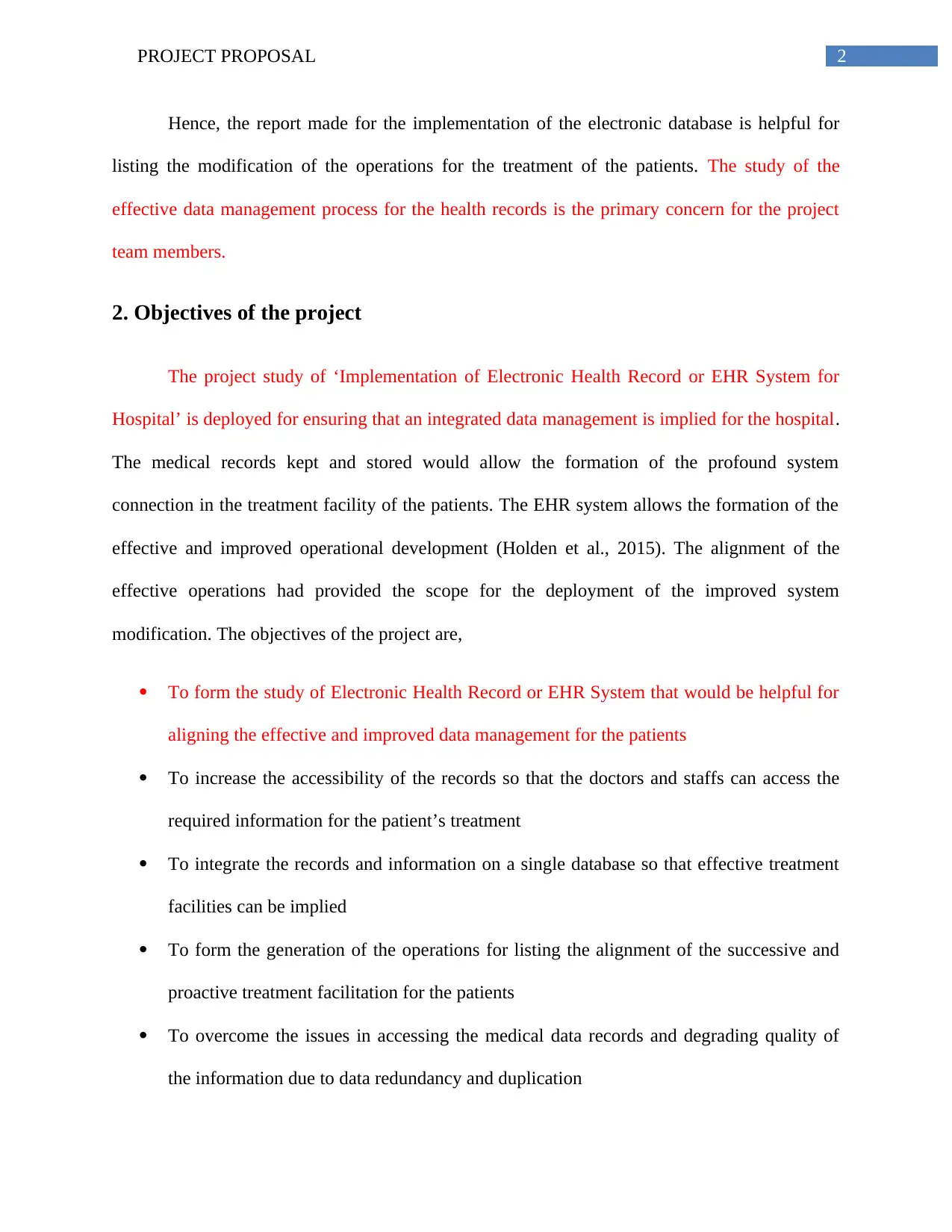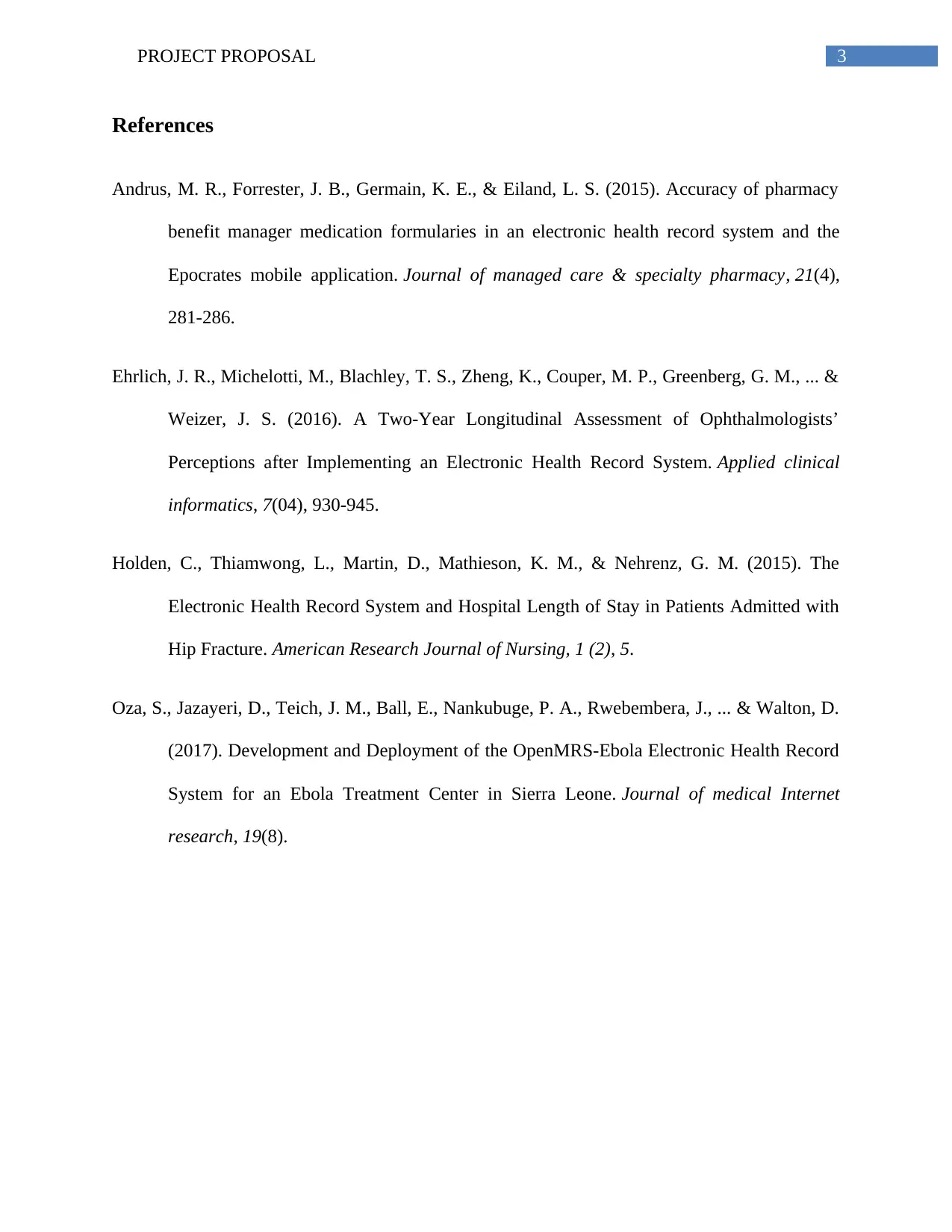EHR System Implementation: A Project Proposal for Data Management
VerifiedAdded on 2023/06/15
|4
|872
|350
Project
AI Summary
This project proposal outlines the implementation of an Electronic Health Record (EHR) system in a hospital to address the limitations of manual record-keeping. The proposal identifies problems such as difficulties in accessing medical records and degradation in data quality due to redundancy and duplication. The project's objectives include studying EHR systems for improved data management, enhancing record accessibility for medical staff, integrating records into a single database, and facilitating proactive patient treatment. The goal is to streamline data management, improve the quality of medical records, and enhance the overall efficiency of patient care within the hospital.

Running head: PROJECT PROPOSAL
Project Proposal
Name of the Student:
Student ID:
Name of the University:
Author’s note:
Project Proposal
Name of the Student:
Student ID:
Name of the University:
Author’s note:
Paraphrase This Document
Need a fresh take? Get an instant paraphrase of this document with our AI Paraphraser

1PROJECT PROPOSAL
1. Problem Statement
The project is based on the study of the implementation of an electronic health record
system that would involve the use of survey data for forming the effective data analysis. The
development of technology had helped in increasing the growth of the effective and improved
medical treatments (Oza et al., 2017). However the increase in the number of data and
information regarding health treatment had made it evitable for using an integrated data
management system. The problems of using the old manual records for patient’s treatments are,
Issue in Access of Medical Records: Most of the times, it becomes impossible for listing
the development of the effective communication in the operation of the effective and improved
transfer of information. The records kept at varied source had resulted in forming the problem for
developing the transfer of the records (Ehrlich et al., 2016). The successive transfer of
information was not possible and the alignment of the operations was not deployed for being
accessed easily. For example: the treatment of patients might require a number of records such as
his/her sugar reports, blood pressure report, previous medication, and post medication history.
Degradation in Quality of Records: The records kept separately would have the facility
for implementing the effective and improved records for the operations of the system
development (Andrus et al., 2015). The increase in the volume of the activities had been helpful
for listing the development of the improved activities for the patient’s data management. The
formation of the operations had resulted in listing the modification of the activities of the
operation. The information storage would have to face the issues of data replication and
duplication, information errors, and cross data errors.
1. Problem Statement
The project is based on the study of the implementation of an electronic health record
system that would involve the use of survey data for forming the effective data analysis. The
development of technology had helped in increasing the growth of the effective and improved
medical treatments (Oza et al., 2017). However the increase in the number of data and
information regarding health treatment had made it evitable for using an integrated data
management system. The problems of using the old manual records for patient’s treatments are,
Issue in Access of Medical Records: Most of the times, it becomes impossible for listing
the development of the effective communication in the operation of the effective and improved
transfer of information. The records kept at varied source had resulted in forming the problem for
developing the transfer of the records (Ehrlich et al., 2016). The successive transfer of
information was not possible and the alignment of the operations was not deployed for being
accessed easily. For example: the treatment of patients might require a number of records such as
his/her sugar reports, blood pressure report, previous medication, and post medication history.
Degradation in Quality of Records: The records kept separately would have the facility
for implementing the effective and improved records for the operations of the system
development (Andrus et al., 2015). The increase in the volume of the activities had been helpful
for listing the development of the improved activities for the patient’s data management. The
formation of the operations had resulted in listing the modification of the activities of the
operation. The information storage would have to face the issues of data replication and
duplication, information errors, and cross data errors.

2PROJECT PROPOSAL
Hence, the report made for the implementation of the electronic database is helpful for
listing the modification of the operations for the treatment of the patients. The study of the
effective data management process for the health records is the primary concern for the project
team members.
2. Objectives of the project
The project study of ‘Implementation of Electronic Health Record or EHR System for
Hospital’ is deployed for ensuring that an integrated data management is implied for the hospital.
The medical records kept and stored would allow the formation of the profound system
connection in the treatment facility of the patients. The EHR system allows the formation of the
effective and improved operational development (Holden et al., 2015). The alignment of the
effective operations had provided the scope for the deployment of the improved system
modification. The objectives of the project are,
To form the study of Electronic Health Record or EHR System that would be helpful for
aligning the effective and improved data management for the patients
To increase the accessibility of the records so that the doctors and staffs can access the
required information for the patient’s treatment
To integrate the records and information on a single database so that effective treatment
facilities can be implied
To form the generation of the operations for listing the alignment of the successive and
proactive treatment facilitation for the patients
To overcome the issues in accessing the medical data records and degrading quality of
the information due to data redundancy and duplication
Hence, the report made for the implementation of the electronic database is helpful for
listing the modification of the operations for the treatment of the patients. The study of the
effective data management process for the health records is the primary concern for the project
team members.
2. Objectives of the project
The project study of ‘Implementation of Electronic Health Record or EHR System for
Hospital’ is deployed for ensuring that an integrated data management is implied for the hospital.
The medical records kept and stored would allow the formation of the profound system
connection in the treatment facility of the patients. The EHR system allows the formation of the
effective and improved operational development (Holden et al., 2015). The alignment of the
effective operations had provided the scope for the deployment of the improved system
modification. The objectives of the project are,
To form the study of Electronic Health Record or EHR System that would be helpful for
aligning the effective and improved data management for the patients
To increase the accessibility of the records so that the doctors and staffs can access the
required information for the patient’s treatment
To integrate the records and information on a single database so that effective treatment
facilities can be implied
To form the generation of the operations for listing the alignment of the successive and
proactive treatment facilitation for the patients
To overcome the issues in accessing the medical data records and degrading quality of
the information due to data redundancy and duplication
⊘ This is a preview!⊘
Do you want full access?
Subscribe today to unlock all pages.

Trusted by 1+ million students worldwide

3PROJECT PROPOSAL
References
Andrus, M. R., Forrester, J. B., Germain, K. E., & Eiland, L. S. (2015). Accuracy of pharmacy
benefit manager medication formularies in an electronic health record system and the
Epocrates mobile application. Journal of managed care & specialty pharmacy, 21(4),
281-286.
Ehrlich, J. R., Michelotti, M., Blachley, T. S., Zheng, K., Couper, M. P., Greenberg, G. M., ... &
Weizer, J. S. (2016). A Two-Year Longitudinal Assessment of Ophthalmologists’
Perceptions after Implementing an Electronic Health Record System. Applied clinical
informatics, 7(04), 930-945.
Holden, C., Thiamwong, L., Martin, D., Mathieson, K. M., & Nehrenz, G. M. (2015). The
Electronic Health Record System and Hospital Length of Stay in Patients Admitted with
Hip Fracture. American Research Journal of Nursing, 1 (2), 5.
Oza, S., Jazayeri, D., Teich, J. M., Ball, E., Nankubuge, P. A., Rwebembera, J., ... & Walton, D.
(2017). Development and Deployment of the OpenMRS-Ebola Electronic Health Record
System for an Ebola Treatment Center in Sierra Leone. Journal of medical Internet
research, 19(8).
References
Andrus, M. R., Forrester, J. B., Germain, K. E., & Eiland, L. S. (2015). Accuracy of pharmacy
benefit manager medication formularies in an electronic health record system and the
Epocrates mobile application. Journal of managed care & specialty pharmacy, 21(4),
281-286.
Ehrlich, J. R., Michelotti, M., Blachley, T. S., Zheng, K., Couper, M. P., Greenberg, G. M., ... &
Weizer, J. S. (2016). A Two-Year Longitudinal Assessment of Ophthalmologists’
Perceptions after Implementing an Electronic Health Record System. Applied clinical
informatics, 7(04), 930-945.
Holden, C., Thiamwong, L., Martin, D., Mathieson, K. M., & Nehrenz, G. M. (2015). The
Electronic Health Record System and Hospital Length of Stay in Patients Admitted with
Hip Fracture. American Research Journal of Nursing, 1 (2), 5.
Oza, S., Jazayeri, D., Teich, J. M., Ball, E., Nankubuge, P. A., Rwebembera, J., ... & Walton, D.
(2017). Development and Deployment of the OpenMRS-Ebola Electronic Health Record
System for an Ebola Treatment Center in Sierra Leone. Journal of medical Internet
research, 19(8).
1 out of 4
Related Documents
Your All-in-One AI-Powered Toolkit for Academic Success.
+13062052269
info@desklib.com
Available 24*7 on WhatsApp / Email
![[object Object]](/_next/static/media/star-bottom.7253800d.svg)
Unlock your academic potential
Copyright © 2020–2025 A2Z Services. All Rights Reserved. Developed and managed by ZUCOL.





